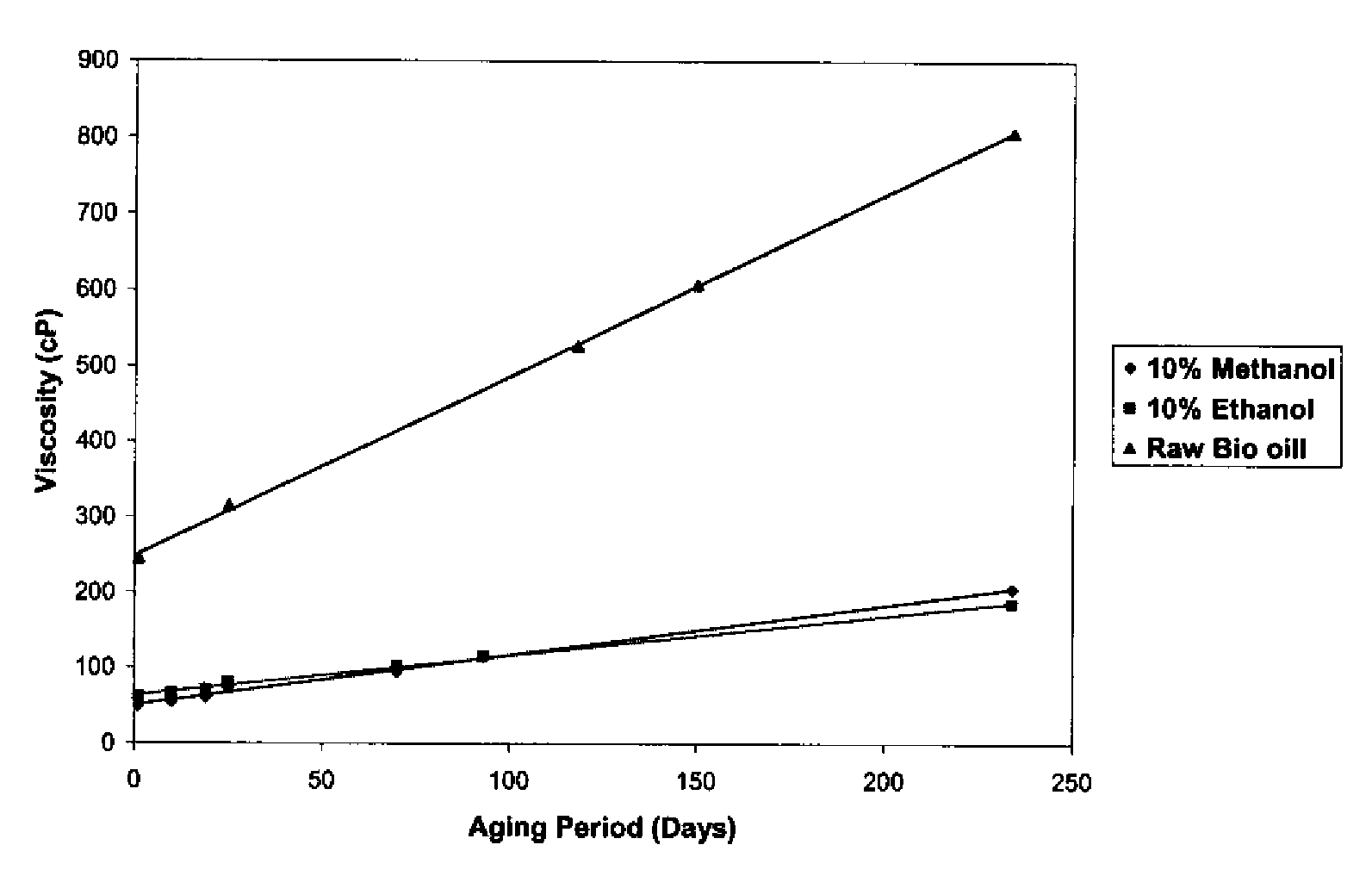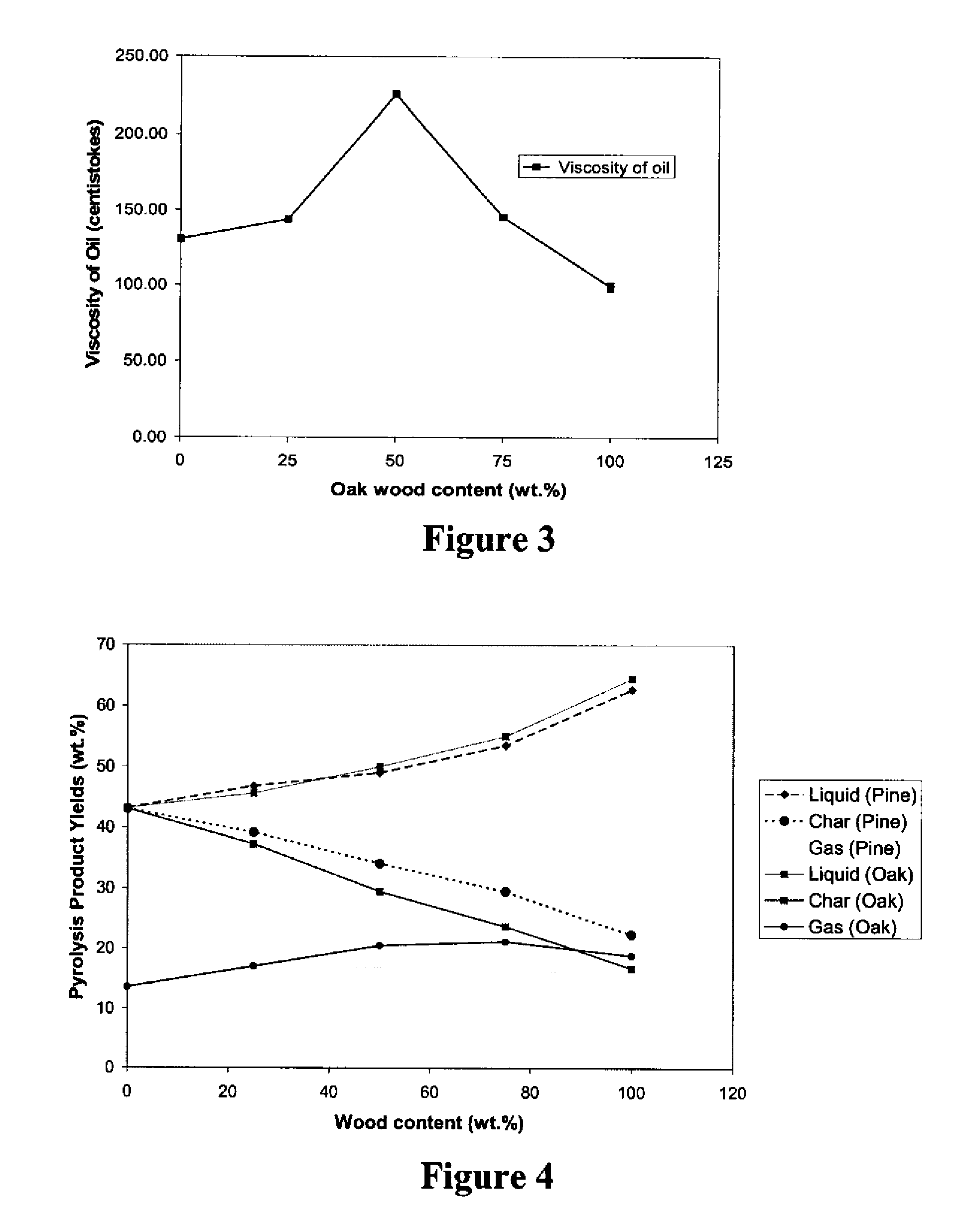Thermochemical method for conversion of poultry litter
a technology of thermochemical conversion and poultry litter, which is applied in the direction of biofuels, fuels, waste based fuels, etc., can solve the problems of affecting the use of poultry litter, the limitations of traditional land application methods, and the difficulty in achieving the conversion effect of poultry litter,
- Summary
- Abstract
- Description
- Claims
- Application Information
AI Technical Summary
Benefits of technology
Problems solved by technology
Method used
Image
Examples
example 1
[0038]A thermochemical conversion method has been developed that converts poultry litter into at least three products: producer gas, bio-oil and char (slow—release fertilizer or black manure). The black manure (slow-release fertilizer) yield was 40 wt % of the starting feedstock and contained all the essential minerals (phosphorous, potassium, calcium, sodium, and a fraction of nitrogen) in the raw poultry litter. The rate of release of potassium from the “black manure” was three times less than that in the raw poultry litter and the rate of phosphorus and calcium release was ten times less than that from the raw poultry litter.
[0039]The pyrolysis studies were conducted in a two-inch (50 mm) bubbling fluidized bed reactor located at the Department of Biological Systems Engineering at Virginia Tech in Blacksburg, Va. The reactor consists of a 2-in. (50 mm) schedule 40 stainless steel pipe, 20 in. (500 mm) high (including a 5.5 in. (140-mm) preheater zone be...
example 2
Control of Odor in Poultry Litter Before Pyrolysis
[0044]In order to make the pyrolysis of poultry litter more worker and environmentally-friendly, a litter amendment procedure was developed such that when the litter is treated with varying amounts of Amosoak, this reduces the odor from the litter. Amosoak is a proprietary compound comprising steam treated agricultural residue of acidic pH in water and is described above. The amount of Amosoak incorporated into litter was from 1 wt % to 20 wt % of the dry litter. The addition of Amosoak to the litter bad two positive effects: the yield of biooil from the litter increased from 40 to 50% and the amount of gas produced decreased. The Amosoak also influenced the acidity of the biooil. Thus, a technique has been developed to control the pH of the biooil. The pH of the untreated biooil ranged from 6 to 8, but with the addition of Amosoak, the pH range of the oil can reduced to as low as 4 depending on the amount of Amosoak added to the lit...
example 3
Control of pH and Increase in Oil Yield
[0045]We also demonstrated that the pH and yield of the biooil can be controlled by incorporation of various concentrations of fresh wood shavings into the poultry litter. Wood shavings concentrations of 25 wt % to 75 wt % were incorporated into the poultry litter. FIGS. 1, 2, 3, and 4 show the influence of the wood shavings on the biooil properties and the yield of biooils. Table 8 shows the pyrolysis yields. Table 9 shows the physiochemical properties of oils produced at various concentrations of pine wood shavings. As the wood shavings content increased, the biooil yield increased and its pH decreased. The viscosity of the biooil and its density were also strongly affected by the amount of wood shavings added. Up to 50 wt % addition of wood shavings increased the viscosity of the oil, but above 50%, the oil viscosity started to decrease. Table 10 shows the properties of the pyrolysis products made from starting materials having varying conce...
PUM
| Property | Measurement | Unit |
|---|---|---|
| temperature | aaaaa | aaaaa |
| temperature | aaaaa | aaaaa |
| temperature | aaaaa | aaaaa |
Abstract
Description
Claims
Application Information
 Login to View More
Login to View More - R&D
- Intellectual Property
- Life Sciences
- Materials
- Tech Scout
- Unparalleled Data Quality
- Higher Quality Content
- 60% Fewer Hallucinations
Browse by: Latest US Patents, China's latest patents, Technical Efficacy Thesaurus, Application Domain, Technology Topic, Popular Technical Reports.
© 2025 PatSnap. All rights reserved.Legal|Privacy policy|Modern Slavery Act Transparency Statement|Sitemap|About US| Contact US: help@patsnap.com



